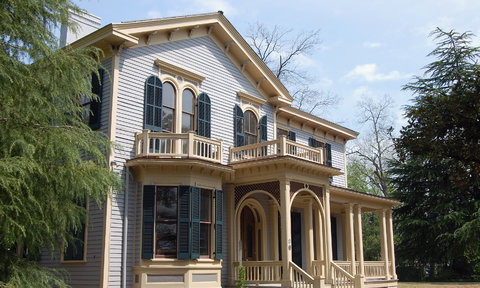Historic House Museums
 The Washington Post termed the debate over the Historic House Museum "the great historic house museum debate." I staunchly disagree with the idea that historic house museums should be eradicated, but I do agree that to stay relevant they must vastly change their interpretations. While I do not support the "final solution" for historic house museums, I do see the validity in closing some museums that only have slight historical significance, lack of resources, or are in much need of repair. Historic house museums are valuable assets to communities, but an over inundation of them will not help them retain their relevance.
The Washington Post termed the debate over the Historic House Museum "the great historic house museum debate." I staunchly disagree with the idea that historic house museums should be eradicated, but I do agree that to stay relevant they must vastly change their interpretations. While I do not support the "final solution" for historic house museums, I do see the validity in closing some museums that only have slight historical significance, lack of resources, or are in much need of repair. Historic house museums are valuable assets to communities, but an over inundation of them will not help them retain their relevance.
In order to "save" the historic house museum, I think a combination of narrative storytelling, interdisciplinary methods, usage of "difficult history" and uncommon interpretations need to be used. The common strategy of focusing on the furniture and the architecture of the house may interest some very specific visitors, and those options should be available for them, but house museums should be growing and pushing their visitors. In her article, Dr. Hillary Lowe argues for more engagement with narrative storytelling in historic house museums, as well as for more interdisciplinary approaches to interpretation. Lowe uses literary house museums as a case study and makes the point that these museums often see more success and interpret more controversial subject matter than the traditional historic house museum.
In Safe Containers for Dangerous Memories by Sarah Pharon, Sally Roesch Wagner, Barbara Lau, and Marie Jose Balana Caballero analyze the historic house museum as part of the International Coalition of Sites of Conscience. While most house museums are regarded as stuffy and in need of renewed interpretation they focus on examples such as the Lower East Side Tenement Museum in New York City and the Liberation War Museum in Bangladesh which engage controversial subjects, with relevancy to current political issues, and take activist stands. While taking activist stands is controversial, exhibits with relevance to the present make visitors see the relevance of history. These are also examples of house museums that have managed to convey their activist messages in a way that attracts large numbers of visitors.
While engaging narrative, activist stances, and being more interdisciplinary are all ways to reinterpret house museums, there are other ways to do. Many of my colleagues at the University of South Carolina worked on the reinterpretation of the Woodrow Wilson House. The house was formerly interpreted as the place President Wilson spent his teenage years, but this was not working to educate the public effectively or bring in visitors. Historic Columbia decided to focus on the time period Wilson was living in the city and focused on life in Columbia during reconstruction. Reconstruction is not frequently interpreted or taught in public schools in the South so this interpretation remained controversial, but it also attracted visitors.
To remain relevant house museums need to reinterpret. The mere fact that a historically significant person lived in one is not enough to sustain house museums or attract interest. This is important for our reinterpretation of the Powel house. The Powel’s and the architecture are not attracting a diverse audience, but an overarching narrative and tours based on politically relevant topics could help. This has inspired me to think of our walking tour of the Jewish Quarter in a more presentist way as to connect to and attract visitors.